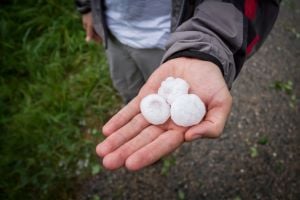 A severe thunderstorm can roll through your neighborhood, bringing lightning and damaging wind, while nearby there could be hail damage. Regarding unpredictable weather, hail and the damage it creates fits the bill.
A severe thunderstorm can roll through your neighborhood, bringing lightning and damaging wind, while nearby there could be hail damage. Regarding unpredictable weather, hail and the damage it creates fits the bill.
So, how is hail created? Hailstones are created when raindrops are forced upward by thunderstorm updrafts into the cold atmosphere. As hailstones collide with water, they grow. Eventually, they fall back to earth damaging homes, cars, and trees. They can even cause injury to people, pets, and livestock. The size of the hailstone and the speed at which it falls can cause minor or extreme damage. Check out this list to help gain perspective regarding the size of hailstones which are measured by their diameter.
- Pea = 1/4-inch
- Mothball = 1/2-inch
- Penny = 3/4-inch
- Nickel = 7/8 inch
- Quarter = 1 inch
- Ping-pong ball = 1 1/2 inch
- Golf ball = 1 3/4 inch
- Tennis ball = 2 1/2 inch
- Baseball = 2 3/4 inch
- Teacup = 3 inch
- Softball = 4 inch
- Grapefruit = 4 1/2 inch
Here are some claim scenarios to help you understand how your insurance policy may provide coverage.
Claim scenario number one.
It’s a beautiful summer day, and you’re enjoying lemonade on your patio. As time passes, the sky gets darker. Suddenly, you receive an alert on your smartphone that your area is under a severe thunderstorm warning. You safely get inside, and the sky opens, sending down heaving rain and hailstones. After the storm passes, you begin hearing reports that your area received hail. Because you're not sure if your home is damaged, you decide to call your insurance company. Your insurance company sends out an adjuster, and they determine that your roof is damaged. To learn more about the claim process click here.
Claim scenario number two.
Because of hail in your area, you decided to call your insurance company. Your insurance company sends out an adjuster, and they determine there’s no damage to your roof. You talk to your neighbor a few days later and learn their roof was damaged and will be replaced because they have replacement cost coverage. This is a common scenario that many neighborhoods face. Hail is highly unpredictable. It can strike your neighbor’s home but not yours. Here are some factors that affect roof damage.
- Roof age and condition
- Density of hail
- Size of hail
- The pitch of the roof
- Overhanging trees
- Direction of hail
- Duration of hail
Claim scenario number three.
It’s a beautiful, warm, sunny afternoon, so you decide to wash your car. You notice that the sky is dark in the distance, and you can see lightning flashes. Suddenly, you receive an alert on your smartphone that your area is under a severe thunderstorm warning. You rush into your home to close all the windows. Instantaneously the sky opens, sending down heavy rain and hailstones. Unfortunately, this prevents you from parking your car in your garage. When the sun appears, you go outside to find your vehicle significantly damaged. If you purchased comprehensive coverage on your car insurance policy, you’ll have coverage to repair or replace your car. You’ll have to pay the deductible. If you only have collision or liability insurance, no coverage will be available to repair or replace your car. You'll have to pay for the damage out of your pocket.
Claim scenario number four.
The same storm that damaged your roof and car also damaged your shed and fence. In this scenario, figuring out if your policy provides coverage can be confusing. Click here for an in-depth analysis of how coverage may apply.
After a severe storm that produced hail passes through and damages your neighborhood, contractors will likely start knocking on your door. Click here for some valuable information that can help you.
Do you have any suggestions or information you’d like to share? I'd love to hear from you. Please share them in the box below.
This article is intended for general educational and illustrative purposes only and should not be construed to communicate legal or professional advice. Further, this article is not an offer to sell insurance. Please consult with your licensed insurance agent for specific coverage details and your insurance eligibility. All policies are subject to the terms, conditions, limitations, definitions, and exclusions contained therein.





